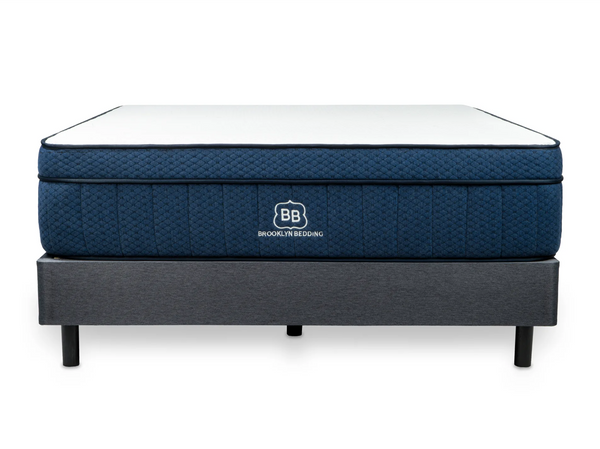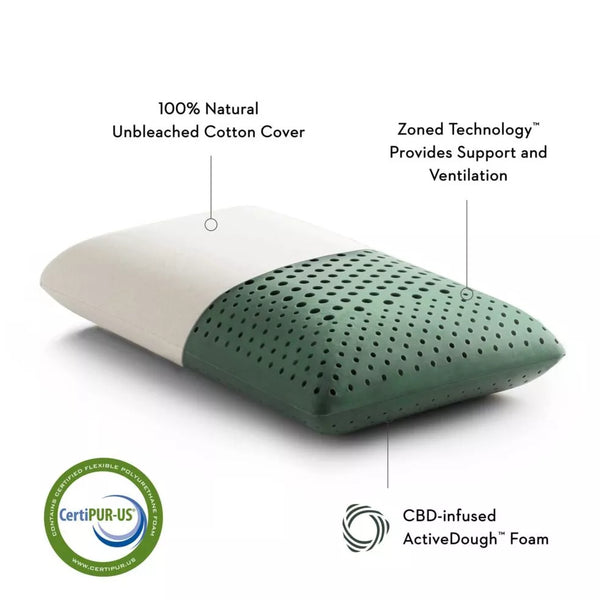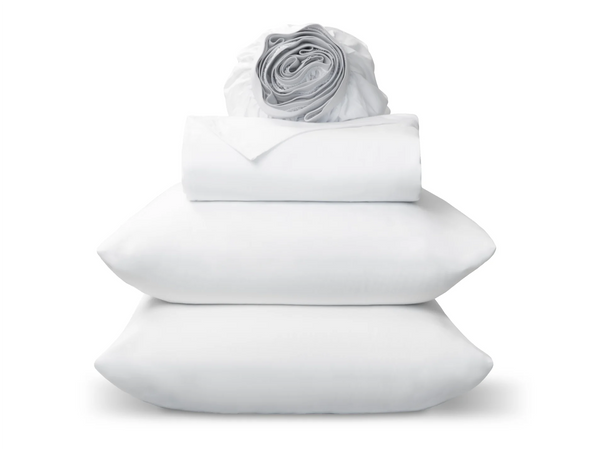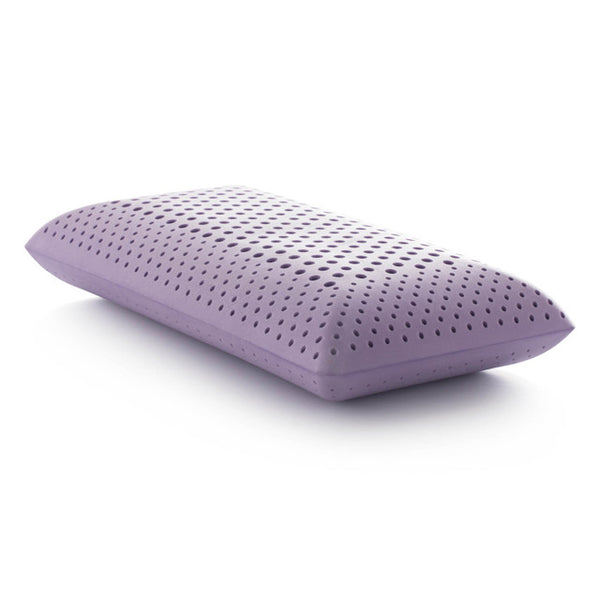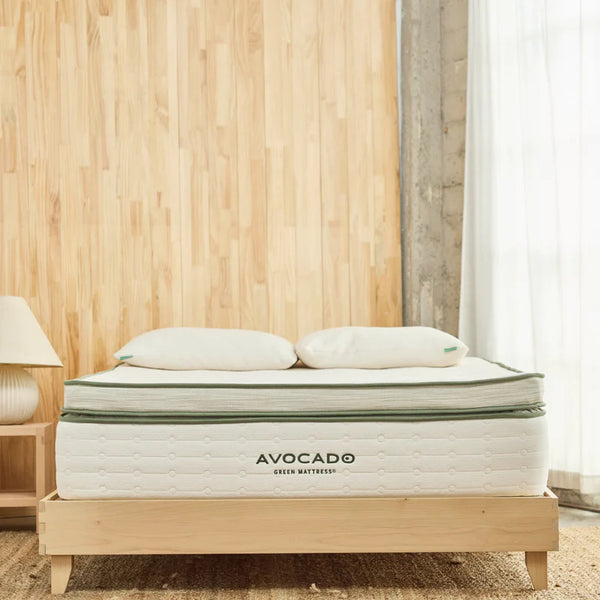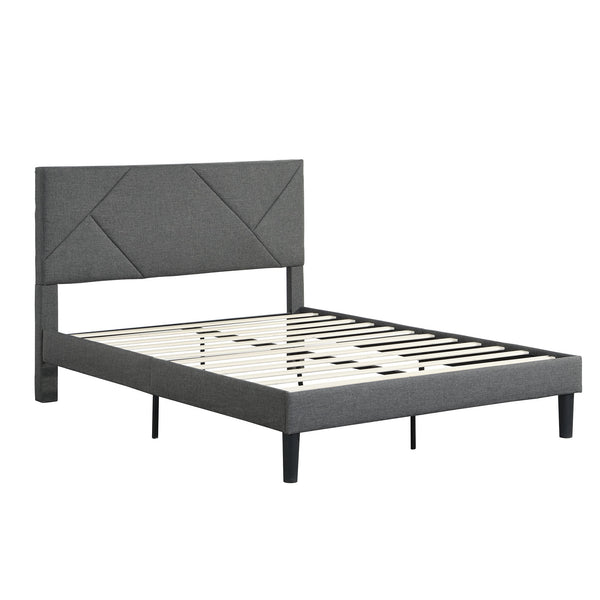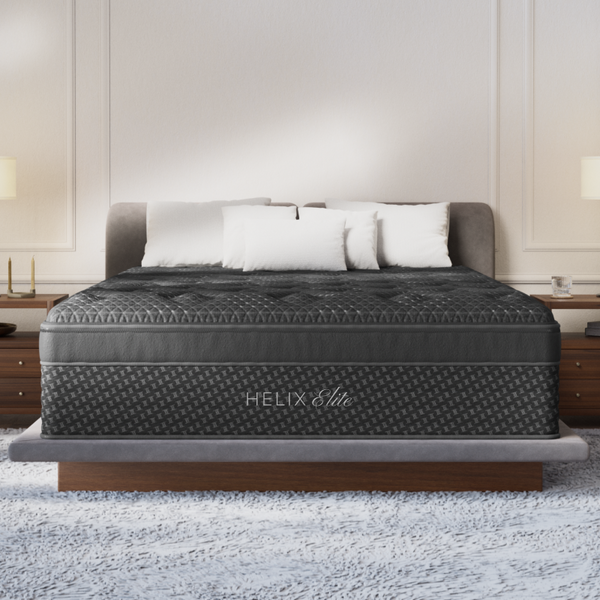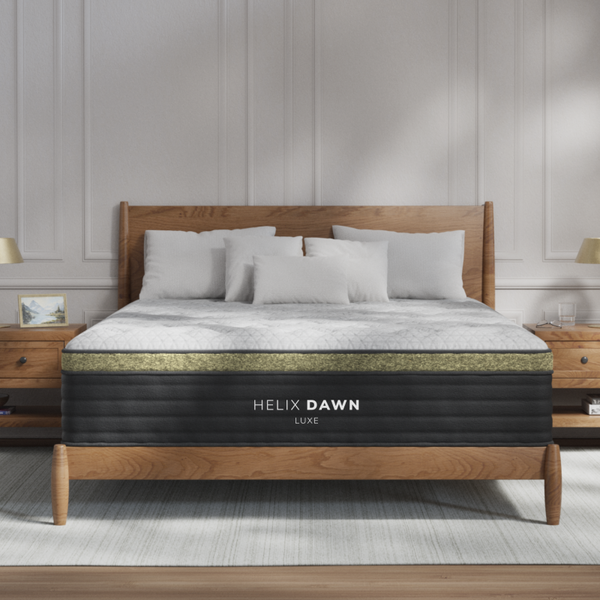When I first started helping customers at The Sleep Loft, one term kept coming up: hybrid mattress. But what does hybrid mattress mean, exactly?
A hybrid mattress combines two different mattress technologies in one bed. Think of it like getting the best of both worlds. These mattresses pair the responsive support of innerspring coils with the pressure-relieving comfort of foam or latex layers.
The result? A sleep surface that addresses many common complaints people have about traditional all-foam or all-spring mattresses.
Key Takeaway
- A hybrid mattress combines foam comfort layers (typically 2-3 inches thick) with an innerspring coil support system
- Hybrid construction offers better cooling than all-foam mattresses while providing more pressure relief than traditional innerspring beds
- These mattresses typically cost between $1,200 and $2,000 for a queen size and last 8-12 years with proper care
- Hybrid mattresses work well for couples, hot sleepers, and people who want balanced comfort without sacrificing support
How Hybrid Mattresses Are Built
To truly define hybrid mattress construction, we need to break down what's actually inside these beds.
The Foundation Layer
Every hybrid mattress starts with a base layer of high-density foam. This layer typically measures 1-2 inches thick and provides stability for everything above it.
You won't feel this layer when you sleep. But it prevents sagging and helps the mattress maintain its shape over years of use.
The Coil Support Core
Above the foundation sits the heart of what makes a hybrid mattress a hybrid: the coil system.
Most quality hybrid mattresses use individually wrapped coils. These are also called pocketed coils or Marshall coils. Each coil is wrapped in fabric and moves independently from its neighbors.
This independent movement creates two important benefits. First, when you press down on one area of the mattress, only the coils directly beneath you compress. Second, motion doesn't transfer easily across the bed.
The coil count in hybrid mattresses typically ranges from 800 to 1,200 for a queen size. Higher coil counts generally mean better support and motion isolation.
Some hybrid mattresses feature zoned coil systems. These have firmer coils in the center to support your hips and softer coils at the head and foot for comfort.
The Transition Layer
Between the supportive coils and the soft comfort layers, you'll find a transition layer.
This layer is usually made from firmer polyfoam. It prevents you from feeling the coils directly and helps distribute your weight evenly across the support system.
Think of it as a buffer zone that makes the transition from soft to firm feel more gradual and comfortable.
The Comfort Layers
The top of a hybrid mattress is where the magic happens in terms of how the bed feels.
According to the Sleep Foundation, hybrid mattresses feature comfort layers at least 3 inches thick. These layers can include memory foam, polyfoam, latex, or even microcoils.
Memory foam comfort layers conform closely to your body. They cradle pressure points like your hips and shoulders, which makes them popular with side sleepers.
Latex comfort layers provide a bouncier, more responsive feel. They sleep cooler than memory foam and offer firmer support while still contouring to your body.
Some hybrid mattresses use gel-infused foams in their comfort layers. The gel helps pull heat away from your body for cooler sleep.
The Cover
Finally, the mattress cover wraps everything together.
Many hybrid mattresses feature quilted covers with additional padding for surface-level comfort. Some use breathable fabrics like Tencel or include materials that help manage temperature.
The cover is what you touch and feel first, so manufacturers put real thought into making it soft, durable, and temperature-neutral.
Why Hybrid Mattresses Have Become So Popular
The hybrid mattress market has grown a lot in recent years. According to market research, the global hybrid mattress market reached $3.23 billion in 2025 and is projected to hit $5.77 billion by 2030.
That's a 12.30% growth rate each year.
They Address Common Mattress Complaints
Traditional innerspring mattresses offer great support and breathability, but they don't provide much pressure relief, especially for side sleepers.
All-foam mattresses excel at pressure relief and motion isolation. But many people complain they sleep too hot or feel stuck in the mattress.
Hybrid mattresses were designed to solve both problems at once.
The coil system provides the airflow and support people love about innerspring beds. The foam or latex comfort layers deliver the pressure relief and contouring that all-foam mattresses are known for.
They Work for Multiple Sleep Positions
One of my favorite things about hybrid mattresses is their versatility.
Back sleepers get the support they need from the coil system while enjoying some contouring around the lower back. Stomach sleepers benefit from the responsive surface that prevents their hips from sinking too deep. Side sleepers appreciate the pressure relief on their shoulders and hips.
This versatility makes hybrid mattresses a smart choice for combination sleepers who change positions throughout the night.
They Sleep Cooler
Temperature control is huge when it comes to sleep quality.
Research consistently shows that hybrid mattresses outperform traditional memory foam in temperature regulation. The coil system creates natural pathways for air to flow through the mattress core.
This airflow helps move body heat away instead of trapping it like solid foam constructions do.
In our experience at The Sleep Loft, many customers report sleeping noticeably cooler on hybrid mattresses compared to their previous all-foam beds.
What Are Hybrid Mattresses Good For?
Based on what we see at our showroom and from customer feedback, hybrid mattresses excel in several specific situations.
For Couples and Partners
If you share your bed, a hybrid mattress might be exactly what you need.
The individually wrapped coils minimize motion transfer. When your partner moves or gets out of bed, you're less likely to feel it on your side.
Testing shows hybrid mattresses achieve motion isolation scores of 8.0 out of 10. That's much better than traditional innerspring beds, though slightly below all-foam mattresses.
The edge support on hybrid mattresses also tends to be stronger than foam beds. Average edge support scores reach 8.7 compared to 8.6 for all mattresses. This means you can use the full surface of the bed without feeling like you might roll off.
For Hot Sleepers
If you regularly wake up sweating, you need to understand what hybrid means in a mattress in terms of cooling.
The coil structure allows air to circulate freely through the mattress. This creates what engineers call convective cooling, where warm air naturally rises and escapes while cooler air flows in.
Hybrid mattresses achieve cooling scores of 8.7 compared to 8.2 for foam mattresses in testing.
Many hybrid models enhance this natural cooling with gel-infused foams, breathable covers, or latex layers.
For People Who Want Balance
Some people love the hug of memory foam. Others prefer the bounce of a traditional mattress.
If you're somewhere in the middle, hybrid construction might be exactly what you need.
The foam layers provide enough contouring to relieve pressure points, but the coils underneath keep you from sinking too deep and maintain that responsive feel many people want.
Testing shows hybrid mattresses achieve bounce measurements of 10.30 inches compared to 8.14 inches for foam mattresses. This makes it easier to change positions and move around in bed.
For People with Back Pain
Many people find hybrid mattresses helpful for back pain relief.
The combination of supportive coils and cushioning foam creates what researchers found to be ideal: medium-firm support that reduces pressure points while maintaining proper spinal alignment.
A survey of 268 people with low back pain discovered that those sleeping on very hard mattresses had the poorest sleep quality. Medium-firm options provided better outcomes.
Hybrid mattresses excel at providing this balanced support across different body types and sleep positions.
How Hybrid Mattresses Compare to Other Types
Understanding what's a hybrid mattress means knowing how it stacks up against other options.
Hybrid vs. All-Foam Mattresses
All-foam mattresses offer better motion isolation with scores of 8.6 compared to 8.0 for hybrids.
But hybrid mattresses win in several other categories. They sleep cooler, with temperature scores of 8.7 versus 8.2 for foam beds. They offer better edge support and more bounce.
Hybrid mattresses also tend to be more durable in the long run. The steel coils maintain their support longer than foam support cores, which can develop permanent body impressions over time.
The main advantage of all-foam mattresses is their lighter weight and sometimes lower price point.
Hybrid vs. Innerspring Mattresses
Traditional innerspring mattresses excel at breathability and responsiveness.
But they fall short on pressure relief and motion isolation. The connected coil systems in older innerspring beds transfer motion easily across the surface.
Hybrid mattresses use individually wrapped coils that move independently. This provides motion isolation closer to foam beds while maintaining the supportive, responsive feel of springs.
Hybrid construction also adds comfort layers that traditional innerspring beds lack. This means better pressure relief for your shoulders, hips, and other sensitive areas.
Hybrid vs. Latex Mattresses
Latex mattresses offer natural responsiveness, excellent breathability, and impressive durability. Quality latex beds can last 20-25 years.
The main differences come down to feel and price. Latex mattresses typically have a bouncier, more resilient feel than hybrid mattresses with memory foam comfort layers.
Latex beds also command premium pricing, often exceeding hybrid mattress costs.
Some hybrid mattresses use latex in their comfort layers. These latex hybrids combine the best features of both constructions, achieving particularly high performance scores of 8.88 in testing.
How Long Do Hybrid Mattresses Last?
Durability matters when you're investing in a new mattress.
Industry testing puts hybrid mattresses through 30,000 compression cycles using a 309-pound roller. This simulates 8-10 years of typical use.
Quality hybrid mattresses typically maintain their structure and support throughout this entire testing period. Real-world data shows hybrid mattresses lasting 6.5 to 7.5 years on average, with premium models extending beyond this range.
Several factors influence how long your hybrid mattress will last.
Material Quality Matters
The density of the foam layers plays a huge role in durability.
High-density memory foam with densities exceeding 4 pounds per cubic foot resists body impressions better than lower-density options. It maintains its contouring properties longer over time.
The coil system quality is equally important. Heavier gauge wire and heat-treated steel show greater resistance to wear. These premium coils maintain their supportive properties throughout extended use.
Proper Care Extends Lifespan
Taking care of your hybrid mattress can significantly extend its service life.
Rotate your mattress every 3-6 months to distribute wear evenly. Use a quality mattress protector to prevent moisture from getting into the foam and coil materials.
Make sure your mattress has proper support underneath. A sagging foundation causes early wear and can void warranties.
Temperature and humidity control in your bedroom helps prevent foam from breaking down faster.
Weight Considerations
Most standard hybrid mattresses are designed to support individuals up to 250 pounds effectively.
Heavier sleepers may experience faster wear, particularly in foam comfort layers. The coil support system helps distribute weight more effectively than all-foam options.
Some manufacturers offer heavy-duty hybrid designs with reinforced coil systems and higher-density foams for sleepers exceeding standard weight ranges.
What to Look for When Shopping for a Hybrid Mattress
Not all hybrid mattresses are created equal.
The lack of industry standards for what makes a hybrid creates some confusion. According to Consumer Reports, some companies market mattresses with minimal foam layers as hybrids, while others require substantial comfort systems.
Understand the Comfort Layer Composition
The type of foam or latex in the comfort layers significantly influences how the mattress feels and performs.
Memory foam provides excellent pressure relief and body contouring. It's great for side sleepers and people who want that hugging sensation. However, it can retain more heat than other materials.
Latex offers a more responsive, bouncy feel. It sleeps cooler than memory foam and provides firmer support while still contouring to your body.
Gel-infused foams attempt to combine memory foam's benefits with improved temperature control.
Pay attention to the thickness of the comfort layers. Quality hybrid mattresses typically feature at least 3 inches of comfort material above the coils.
Check the Coil Specifications
The coil system determines much of the mattress's support and durability.
Look for individually wrapped pocketed coils rather than connected spring systems. Pocketed coils provide better motion isolation and targeted support.
Coil count matters, but it's not the only factor. For a queen-size mattress, look for at least 800 coils, with 1,000-1,200 being ideal.
Coil gauge (wire thickness) affects firmness and durability. Lower gauge numbers indicate thicker wire. A 12-14 gauge is common in quality hybrid mattresses.
Consider Cooling Features
If you sleep hot, look for hybrid mattresses with enhanced cooling technologies.
Breathable cover materials like Tencel or special fabrics actively help manage temperature. Gel-infused foams in the comfort layers can pull heat away from your body.
Some premium hybrids feature special cooling covers or ventilated foam layers that enhance the natural airflow provided by the coil system.
Read the Fine Print on Warranties and Trials
Most hybrid mattresses come with 10-year warranties that cover manufacturing defects and excessive sagging.
Pay attention to what the warranty actually covers. Some warranties have reduced coverage after certain years. Others require specific foundations or limit coverage if you don't use a mattress protector.
Sleep trials are equally important. Look for at least a 100-night trial period that allows you to return the mattress if it's not right for you.
Be aware of any fees associated with returns or exchanges. Some companies charge restocking fees or require you to pay return shipping.
Common Misconceptions About Hybrid Mattresses
As hybrid mattresses have grown in popularity, several myths have emerged.
"All Hybrid Mattresses Feel the Same"
This couldn't be further from the truth.
The feel of a hybrid mattress varies dramatically based on its comfort layer materials, thickness, coil specifications, and overall construction.
A hybrid with thick memory foam comfort layers will feel completely different from one with latex comfort layers. Some hybrids feel very foam-forward, while others maintain a more spring-like character.
"Hybrid Mattresses Are Just More Expensive Innerspring Beds"
While hybrid mattresses do cost more than basic innerspring models, they're fundamentally different products.
The substantial comfort layers in hybrid mattresses provide pressure relief that traditional innerspring beds simply can't match. The individually wrapped coil systems offer better motion isolation and targeted support.
The price difference reflects the more complex construction and higher-quality materials used in hybrid mattresses.
"You Need a Box Spring for a Hybrid Mattress"
Most hybrid mattresses don't require a box spring.
In fact, many manufacturers recommend against using traditional box springs with hybrid mattresses. The independent coil system in hybrid beds provides all the support needed.
A solid platform base, slatted base (with slats no more than 3 inches apart), or adjustable base works best with hybrid mattresses.
"Hybrid Mattresses Are Too Heavy to Handle"
It's true that hybrid mattresses weigh more than all-foam options due to their steel coil systems.
A queen-size hybrid mattress typically weighs 80-120 pounds compared to 50-70 pounds for a comparable foam mattress.
This extra weight can make setup, rotation, and moving more challenging – but it's a trade-off for the support and durability benefits the coil system provides.
Many mattress companies offer white glove delivery services that handle setup and old mattress removal for you.
Who Should Consider a Hybrid Mattress?
Based on what we've learned at The Sleep Loft and from customer feedback, certain types of sleepers benefit most from hybrid construction.
Combination Sleepers
If you change positions frequently during the night, a hybrid mattress adapts well to your needs.
The responsive coil system makes it easy to shift from your back to your side to your stomach. The comfort layers provide pressure relief in each position without letting you sink too deep.
Couples with Different Preferences
Hybrid mattresses often work well for partners who want different things from their mattress.
The balanced construction provides enough contouring for side sleepers while maintaining the support back and stomach sleepers need. The motion isolation keeps you from disturbing your partner when you move.
Many hybrid models come in multiple firmness levels, allowing couples to choose the option that works best for both of them.
Active Individuals and Athletes
People who are physically active often report feeling more comfortable on hybrid mattresses.
The responsive surface makes it easier to get in and out of bed. The pressure relief helps sore muscles recover while the support maintains proper alignment.
Some brands market specific hybrid models designed for athletic recovery, with additional cooling features and targeted support zones.
People Transitioning from Innerspring
If you've always slept on innerspring mattresses but want more pressure relief, a hybrid is a natural next step.
You'll maintain the familiar bounce and responsiveness of springs while gaining the benefits of modern foam comfort layers.
This makes the transition easier than switching directly to an all-foam mattress, which can feel quite different from what you're used to.
Understanding Hybrid Mattress Pricing
Hybrid mattresses typically fall in the mid-to-premium price range.
According to market data, queen-size hybrid mattresses average between $1,200 and $2,000. Entry-level options from direct-to-consumer brands start around $699, while luxury models can exceed $2,500.
What Drives Hybrid Mattress Costs
Several factors influence hybrid mattress pricing.
The quality and type of foam in the comfort layers significantly impacts cost. Natural latex costs more than synthetic foams. High-density memory foam commands premium prices compared to lower-density options.
Coil specifications matter too. Higher coil counts, thicker gauge wire, and zoned support systems increase manufacturing costs.
Premium features like advanced cooling technologies, organic materials, or handcrafted construction add to the price tag.
Calculating Long-Term Value
Looking beyond the initial purchase price reveals hybrid mattresses' true value.
Given typical lifespans of 8-12 years for quality hybrid mattresses, the annual cost often compares well to cheaper options that need replacement more frequently.
A $1,500 hybrid mattress that lasts 10 years costs $150 per year. A $600 budget mattress that needs replacement every 5 years costs $120 per year.
The hybrid provides better sleep quality throughout its lifespan, which can affect your overall health and well-being.
When Sales and Promotions Matter
Major sales events offer real savings on hybrid mattresses.
Memorial Day, Labor Day, Presidents Day, and Black Friday typically feature discounts of 20-40% on hybrid models. Some brands offer these discounts year-round to online shoppers.
If you're shopping for a hybrid mattress, timing your purchase around these events can save hundreds of dollars.
Taking Care of Your Hybrid Mattress
Proper maintenance helps your hybrid mattress reach its full lifespan potential.
Rotation Schedule
Rotate your hybrid mattress 180 degrees every 3-6 months.
This distributes wear more evenly across the mattress surface and helps prevent permanent body impressions in high-use areas.
Most hybrid mattresses are not designed to be flipped. The comfort layers are only on one side, with the support core and base layer on the bottom.
Protection from Moisture and Stains
Invest in a quality mattress protector from day one.
A waterproof protector prevents spills, sweat, and other moisture from getting into the comfort layers and reaching the coil system. This protection extends the mattress's life and keeps it fresh.
Look for protectors that are waterproof but breathable. You don't want to trap heat or compromise the cooling benefits of your hybrid mattress.
Foundation Requirements
Make sure your hybrid mattress has proper support underneath.
A solid platform or slatted base with slats no more than 3 inches apart works well. Some manufacturers require specific foundation types to maintain warranty coverage.
Avoid placing a hybrid mattress directly on the floor. This restricts airflow around the bottom of the mattress and can lead to moisture buildup and mold growth.
Cleaning and Spot Treatment
Address spills and stains immediately to prevent permanent damage.
Blot liquid spills with a clean, dry cloth. Don't rub, as this can push moisture deeper into the mattress layers.
For stains, use a mild detergent mixed with water. Apply sparingly with a cloth, blot the area, and allow it to air dry completely.
Vacuum your mattress every few months to remove dust, dead skin cells, and allergens that build up in the cover and comfort layers.
Real Customer Experiences with Hybrid Mattresses
Customer feedback provides valuable insights into hybrid mattress performance.
What People Love
Temperature control consistently ranks among the top benefits customers report.
Many people switching from all-foam mattresses to hybrids notice immediate improvements in how cool they sleep. The airflow through the coil system makes a real difference.
Customers frequently praise the balanced feel of hybrid mattresses. They appreciate getting pressure relief without feeling stuck or like they're sleeping "in" the mattress rather than "on" it.
The motion isolation gets high marks from couples. Partners report less disturbance when someone gets up during the night or changes positions.
Common Complaints
Weight and handling challenges appear in many customer reviews.
People note that hybrid mattresses are significantly heavier than foam options. This makes rotating the mattress, changing sheets, and moving more difficult.
Some customers report that their hybrid mattress feels different than expected based on in-store testing or firmness ratings. The complex interaction between comfort layers and coil systems can make firmness harder to predict.
A small number of buyers experience early coil noise or comfort layer wear. These issues typically relate to lower-quality construction rather than problems with hybrid design itself.
Success Stories
Research examining hybrid mattress effectiveness found real improvements in multiple areas.
A study using both subjective reviews and objective sleep tracking found that participants reported better sleep quality, reduced pain, lower stress levels, improved mood, and less daytime fatigue after switching to hybrid mattresses.
Objective measurements confirmed improvements in sleep duration, less time awake during the night, enhanced light sleep, improved deep sleep, and increased total sleep time.
Satisfaction studies show people sleeping on hybrid mattresses tend to report higher satisfaction levels compared to those on traditional all-spring beds.
Making Your Decision
Choosing a hybrid mattress requires considering your specific needs and preferences.
Assess Your Sleep Position
Your primary sleep position should guide your hybrid mattress selection.
Side sleepers generally need softer comfort layers that cushion the shoulders and hips. Look for hybrid mattresses with thicker memory foam or latex comfort layers rated medium to medium-soft.
Back sleepers benefit from medium to medium-firm hybrids that support the natural curve of the spine while providing some contouring.
Stomach sleepers need firmer hybrid mattresses that prevent the hips from sinking too deep and causing spinal misalignment.
Consider Your Temperature Sensitivity
If you sleep hot, prioritize hybrid mattresses with enhanced cooling features.
Look for gel-infused foams, breathable covers, and latex comfort layers rather than thick memory foam. Some hybrid models specifically market their cooling capabilities.
If you sleep cold, hybrid mattresses with memory foam comfort layers and quilted covers provide more warmth retention.
Factor in Your Budget
Determine your budget before shopping, but think about long-term value.
A higher-quality hybrid mattress that lasts 10-12 years may be a better investment than a budget option that needs replacement in 5-6 years.
Many retailers offer financing options that make premium hybrid mattresses more accessible. Zero-interest promotional periods can spread the cost over time without additional charges.
Try Before You Buy When Possible
If you can test a hybrid mattress in person, take advantage of the opportunity.
Spend at least 10-15 minutes lying in your typical sleep positions. Pay attention to pressure points, overall comfort, and whether you feel properly supported.
Many online mattress companies offer generous trial periods, often 100 nights or more. This gives you time to adjust to the new mattress and decide if it's right for you.
Read the trial terms carefully. Understand any requirements, fees, or conditions that might apply if you decide to return the mattress.
Frequently Asked Questions
What does hybrid mattress mean?
A hybrid mattress combines an innerspring coil support system with substantial foam or latex comfort layers, typically at least 3 inches thick. This construction blends the responsive support and breathability of coils with the pressure-relieving properties of foam materials. The result is a mattress that offers balanced comfort, better cooling than all-foam beds, and more pressure relief than traditional innerspring mattresses.
Are hybrid mattresses better than memory foam?
Hybrid mattresses aren't universally better than memory foam, but they excel in different areas. Hybrids sleep cooler, with temperature scores of 8.7 versus 8.2 for foam mattresses, and offer better edge support and responsiveness. Memory foam mattresses provide slightly better motion isolation. The best choice depends on your priorities—if you value cooling and ease of movement, choose hybrid; if motion isolation is most important, consider all-foam.
How long do hybrid mattresses last?
Quality hybrid mattresses typically last 6.5 to 7.5 years on average, with premium models extending to 8-12 years with proper care. Lifespan depends on material quality, particularly foam density and coil specifications. High-density foams exceeding 4 pounds per cubic foot and heavy-gauge coils maintain their properties longer. Proper maintenance like regular rotation, using a mattress protector, and ensuring adequate foundation support can extend your hybrid mattress's lifespan.
Do hybrid mattresses need box springs?
No, hybrid mattresses don't need box springs and many manufacturers recommend against using them. The independent coil system in hybrid mattresses provides all the support needed. Instead, use a solid platform base, slatted foundation with slats no more than 3 inches apart, or an adjustable base. Always check your specific mattress manufacturer's recommendations, as using the wrong foundation can void your warranty.
Why are hybrid mattresses more expensive than innerspring?
Hybrid mattresses cost more because they contain substantially more materials and require more complex manufacturing. They feature thick comfort layers of premium foams or latex (typically 3-7 inches) compared to the minimal padding on traditional innerspring beds. Hybrid mattresses also use individually wrapped pocketed coils rather than less expensive connected coil systems. The additional materials and more advanced construction justify the higher price, typically ranging from $1,200 to $2,000 for a queen size.
Can you flip a hybrid mattress?
Most hybrid mattresses cannot be flipped because they're designed with comfort layers only on top. Flipping would put the firm base layer and coil system on top, making the bed extremely uncomfortable. Instead, rotate your hybrid mattress 180 degrees every 3-6 months to distribute wear evenly. A few hybrid models are designed as double-sided flippable mattresses, but these are exceptions. Always check your manufacturer's care instructions.
Do hybrid mattresses sleep hot?
Hybrid mattresses generally sleep cooler than all-foam mattresses due to their coil support systems, which allow natural airflow through the mattress core. Testing shows hybrid mattresses achieve cooling scores of 8.7 compared to 8.2 for foam beds. However, hybrids with thick memory foam comfort layers may retain more heat than those with latex layers or gel-infused foams. For the coolest sleep, choose hybrid mattresses with latex comfort layers, gel-infused foams, or specialized cooling covers.
Are hybrid mattresses good for back pain?
Many people find hybrid mattresses helpful for back pain because they combine supportive coils with pressure-relieving comfort layers. Research shows medium-firm mattresses provide the best outcomes for people with low back pain, and quality hybrid mattresses excel at delivering this balanced support. The coil system maintains proper spinal alignment while foam or latex layers cushion pressure points. Hybrid mattresses work particularly well because they adapt to different sleep positions while maintaining consistent support throughout the night.

